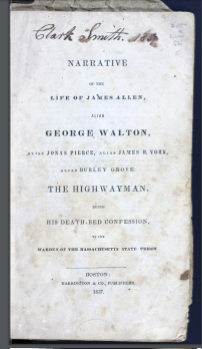Located in a locked room at the beautiful and fascinating Boston Athenaeum is a handwritten copy of Allen's memoir. What makes it so special is the fact that it is bound in the burglar's own skin.
It is housed in a custom-made box and only brought out for special events and pre-scheduled viewings.

“Allen asked that enough of his skin be tanned to provide bindings for two copies of this memoir,” Stephen Z. Nonack writes in Acquired Tastes, an account of the Boston Athenaeum’s collections.
“A sufficient piece of skin was removed from Allen’s back and taken to a local tannery, where it was treated to look like grey deerskin and finally delievered into the hands of… a bookbinder,” the Athenaeum’s website reads.
The practice of binding texts in human skin is known as anthropodermic bibliopegy, and may date back to the French Revolution, when the French Constitution is said to have been bound in the skin of those who opposed the new Republic.
The skin book has been at the Boston Athenaeum so long, it is no longer known how it got there. One theory is that it was donated by John Fenno, Jr.’s daughter sometime in the 19th century.
Despite their collection of more than 150,000 rare books, The Boston Athenaeum Skin Book remains one of its most popular attractions.
Any visitor can get a peak at Allen's memoirs on display in the first floor reading room, but in order to see the skin book, you must be a member, join a scheduled public tour, or request a private viewing at least a week in advance.
